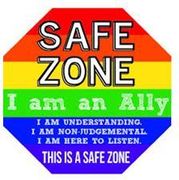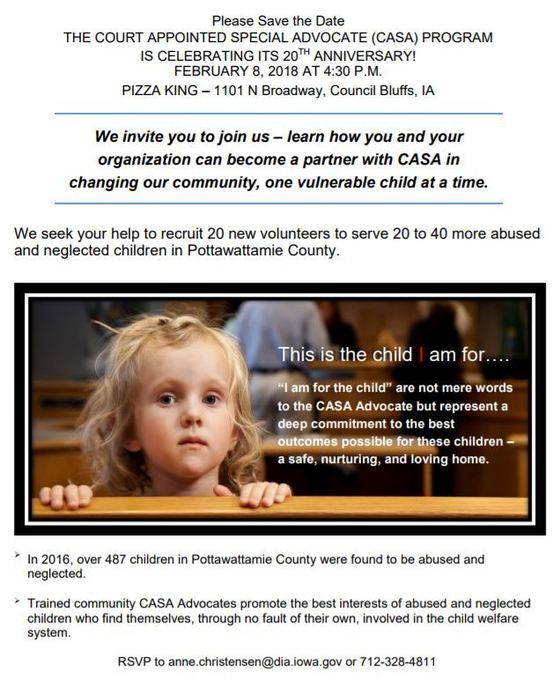
 Thanks to dedicated and committed volunteers who serve on local foster care review boards, citizen reviews continued to be conducted in 50 counties during calendar year 2017. We weathered the budget cut in the spring by suspending five local boards which were all reinstated as of July 1. Several local coordinators have risen to the challenge of adding facilitation responsibilities to their workloads. We’ve also been fortunate to be the recipient of volunteer facilitation services by Pat Cody, Christine Deam and Bill Sackett.
The combined efforts of volunteers, staff and facilitators yielded the following results in CY2017:
- 1,272 reviews held
-
1,917 children reviewed (not unique as some children have multiple reviews in a year)
-
12,436 volunteer hours contributed (includes ongoing training completion)
- 19,896 volunteer mileage contributed
-
99.63% of reports were filed and distributed by Iowa Code mandate of 15 days post review
As we look toward this New Year, we anticipate and are already working on making improvements to the FCRB process and the reports issued to the Courts and interested parties. The improvements are focused on adding more value to the program and conducting more thorough reviews for children’s case that come before the local Review Boards. Stay tuned for more details in the months ahead.
|
The Iowa Child Advocacy Board is proud to announce that it will soon be releasing a new software application called Child Advocacy Match System (CAMS). This unique tool will allow our organization to track case and systemic level data, along with matching children and youth with the most appropriate and available CASA Advocates.
Since the start of 2016, ICAB has been searching for a software solution that could assist with the many tasks of volunteer management and child case maintenance. This system is tailored specifically for the Iowa CASA Program and has some functionality for Foster Care Review Board Program staff as well. Child Advocacy Match is designed to receive applications from interested individuals, and assist staff with managing the necessary training, background screening and the many other tasks required to certify a Court Appointed Special Advocate. The software will keep track of important dates and allow for easy case note, monthly update and CASA Court Report entry. It also provides a healthy listing of network reports and can mine data for program management.
 Child Advocacy Match was developed in partnership with Five Points Technology Group, Inc. a Florida based company. The design and development of software is familiar territory to Five Points as they have developed custom technology solutions for Health and Human Service organizations since 1999, including development of various software for the Iowa Department of Human Services. Over one-third of Five Points staff has direct programmatic, operational and technology experience in child welfare or behavioral health services which provides their clients with a unique advantage by partnering with an organization that thoroughly understands their business and the important mission at hand. Five Points also offers software products to help match and place youth in care with an appropriate foster home; a portal for youth, caregivers, and case managers to access vital case and health information; case management and financial software; as well as reporting and analytical tools. If you would like to learn more about Five Points Technology Group, please visit www.fiveptg.com.
ICAB Staff will be trained on the Child Advocacy Match system in early 2018. Staff will begin using the system first, while implementation for Advocates and Coaches will begin about one month later. Several online, interactive training sessions will be offered during the volunteer-implementation phase and sessions will be recorded to allow all CASA Advocates and Coaches the opportunity to learn at their own pace.
ICAB owes many thanks to the staff and volunteers who have helped with this process. From writing the initial Request for Proposal to the final stages of software testing, this has truly been a team effort. Thanks to all for your work and dedication.
|
For FCRB Members & CASA Advocates: Equality and LGBTQ Youth
 |
|
As we are reminded of the inspiring
messages from Martin Luther King Jr. during the month of January, we can apply
his profound principals of equality and rights to the youth the child welfare
system serves, in particular the Gay, Lesbian, Bisexual, Transgender and
Questioning Youth.
|
 As you
work with young people in child welfare systems, you may work with young people
who are lesbian, gay, bisexual, transgender or questioning their sexual
orientation or gender identity (LGBTQ) whether you realize it or not. Child
welfare professionals, caregivers, and advocates/board members have the duty to
serve these young people with competence and compassion. Unfounded myths and
stereotypes about LGBTQ people have no place in the child welfare world. The
first step toward competent care is to understand basic facts about LGBTQ
people and the issues they face.
WHAT
DOES “LGBTQ” MEAN? In recent years, it has become common to use
the string of letters “LGBTQ” to be inclusive of all individuals and
communities who identify as lesbian, gay, bisexual or transgender or who are
questioning their sexual orientation and/ or gender identity. There is no right
or wrong way to order the letters (e.g., GLBTQ), and some people add additional
letters, including “I” for intersex (or what used to be called hermaphrodism),
“Q” for queer, and “A” for non-LGBTQ allies (e.g., LGBTQQIA).
WHAT CAN
ADVOCATES/BOARD MEMBERS DO? You don’t have to be LGBTQ yourself to be an effective advocate for LGBTQ
youth.
|
Learn terminology. Understand
general terms:
- Lesbian: A woman who
is emotionally, romantically and sexually attracted to other women.
- Gay: A man or woman
who is emotionally, romantically and sexually attracted to the same gender;
some use the term only to identify gay men. The word gay is often preferred
over the word homosexual, which has clinical overtones that some people find
offensive.
- Bisexual: A man or
woman who is emotionally, romantically and sexually attracted to both genders.
Sometimes the attraction to each gender is equal, while for others there may be
a preference for one gender over the other.
- Transgender: An
umbrella term used to describe people whose gender identity, one’s inner sense
of being male or female, or gender expression differs from the sex assigned to
them at birth. It is not dependent upon having sex reassignment surgery. A
person’s genital status, whether one has had surgery or not, does not determine
that person’s gender for the purpose of social behavior, service provisions, or
legal status.
- Gender-nonconforming:
When a person’s gender expression, the outward communication of gender through
behavior or appearance, differs from expectations associated with the sex
assigned to them at birth. Transgender girls are people who were assigned the
sex of male at birth but identify as female. Transgender boys are people who
were assigned the sex of female at birth but identify as male.
Everyone has both a sexual orientation
and a gender identity. Gender identity is different from sexual orientation. See
below. Transgender people may identify as heterosexual, lesbian, gay, bisexual
or questioning. Transgender people may need specialized health care to assist
with their gender transition.
- Questioning: A
person, often an adolescent, who has questions about his or her sexual
orientation or gender identity. Some questioning people eventually come out as
LGBT; some don’t.
- Sexual Orientation:
The gender of the person to whom someone is attracted emotionally,
romantically, sexually, and intimately. Sexual orientation exists on a
continuum and is NOT necessarily congruent with behavior. Examples of sexual
orientation include lesbian, gay, bisexual, or heterosexual. Sexual orientation
involves a process of discovery over time. It is not a volitional choice.
- Gender Identity: The gender with which someone
identifies, regardless of the biological sex label assigned at birth. Gender
identity is a psychological sensing of one’s gender, whereas biological sex
refers to biology and includes male, female, and intersex, (i.e., having some
biological characteristics of both male and female). Examples of gender
identity may include: man, woman, or gender queer (i.e., does not identify with
any gender label). Gender identity is expressed in a range of ways: such as
dress, behavior, speech, appearance, among others. Nonconforming gender
behavior in children can be confusing to everyone and may or may not reflect
the person’s gender identity or sexual orientation. Click here to see image of Genderperson.
- Gender Expression: The
external representation of one’s gender identity through how one presents or
communicates their gender to others. Gender expression may be congruent or
incongruent with someone’s gender identity.
Use
inclusive language. Most of our language
assumes heterosexuality. How many adults would not think twice about asking an adolescent
male, "Do you have a girlfriend?" This question will impose a
significant dilemma for any LGBTQ youth. The question assumes a heterosexual
orientation. A more inclusive LGBTQ question would be: "Is there anyone
special in your life or anyone you feel attracted to?" This allows for a
wider range of client responses. (It is important for the advocate/board member
to mirror the terms and language of the youth when exploring these issues).
Be a
visible advocate. By
standing up for LGBTQ clients facing harassment and discrimination and publicly
supporting their rights, you act as a visible, much-needed advocate for LGBTQ
youth in care. Let all of your clients know that you will not judge them and
will work hard for them no matter what they tell you. Display LGBTQ-friendly
signs and posters for others to see. Never use anti-LGBTQ slurs or rely on
negative stereotypes of LGBTQ people.
Be aware that LGBTQ youth are in out-of-home
care in disproportionate numbers. Approximately
5–10% of the general population is lesbian, gay, bisexual or transgender.
Research shows that young people facing family rejection, harassment and school
failure are more likely to enter the child welfare and juvenile justice
systems. Because many LGBTQ young people face disapproval and
overt rejection from their families, they are more likely to be forced from
their homes into the foster care and homeless populations. Once in foster care,
bias against them may make it harder to find permanent placements for them,
prolonging their stay in child welfare systems.
Be
aware that LGBTQ youth in out-of-home-care are vulnerable to mistreatment and
discrimination. In
foster family homes and group care facilities, LGBTQ youth are often mistreated
and even harmed by staff, caregivers and other young people. Some are forced to
convert to anti-LGBTQ religions and practices.
As a
zealous Advocate/Board Member, confront anti-LGBTQ discrimination at its
source. Rather than simply advocating for the removal of an
LGBTQ youth from an unsafe placement, zealously advocate for an institutional
response to the discrimination and mistreatment. Whether in a child welfare or
juvenile justice facility, in a school or in the community, confronting the
bias or abuse at its source is important in order to ensure that it will not
happen again to another child. Advocate
that someone be prepared to file a grievance or complaint against an offending
institution on behalf of an LGBTQ youth. At the same time, ensure that the
vulnerable youth has been advised of the realities of congregate care. Advocate
for them in their decisions regarding dress and gender expression.
Protect
the privacy of the youth. Even if they are open with you and
others about his/hers/their sexual orientation and identity, the youth should
always be the gatekeeper of this information. Never ‘out’ the youth without
their consent.
Be
aware of the legal protections available to the LGBTQ youth. While
it is important to ensure that the youth’s case permanency plan addresses the
unique needs of the LGBTQ youth, there should be careful consideration as to
whether the plan should include confidential information regarding the youth’s sexual
orientation or gender identity that could later be used against him or her by
those harboring anti-LGBTQ bias. Under the Fourteenth Amendment to the U.S.
Constitution, all young people in state custody have the affirmative right to
protection from harm. This right—the substantive due process liberty interest
in safety—includes the right to appropriate services, medical care and safe
placements.
Advocate
for protecting LGBTQ youth from physical and sexual abuse. LGBTQ
youth are often vulnerable and at increased risk for sexual abuse in juvenile justice
and congregate care settings. The Gay, Lesbian Straight Education
Network (GLSEN) surveys LGBTQ youth in American schools every two years.
Because obtaining accurate information from LGBTQ youth is difficult, many
experts believe that current statistics actually understate the frequency and
severity of youth’s daily fears. Nonetheless, the facts as we know them
underscore the multiple risk factors faced by LGBTQ youth every day. Their 2015
survey found:
- 57.6%
of LGBTQ youth felt unsafe at school with over 30% missing a day of school in
the past month because they felt unsafe or uncomfortable. Over 70% reported avoiding school functions,
or 65% avoiding extra-curricular activities for the same reasons.
- 60%
of LGBTQ students were called names as a result of their sexual orientation or
gender expression peers. Although this peer harassment is a decrease from 84%
in 2003, more than half of students continue to report that they heard
anti-LGBT remarks from teachers or other staff in their school.
- 45%
of LGBTQ youth of color experienced verbal harassment and/or physical assault
in response to perceived sexual orientation and race/ethnicity.
- 27%
of LGBTQ students were shoved or pushed. 13% were physically assaulted
(punched, kicked, injured with a weapon.)
- 48.6%
of LGBTQ students experienced electronic harassment in the past year (via text
messages or postings on Facebook), often known as cyberbullying.
- 59.6%
of LGBTQ students were sexually harassed (e.g., unwanted touching or sexual
remarks) in the past year at school.
- 57.6%
of LGBTQ students who were harassed or assaulted in school did not report the
incident to school staff, most commonly because they doubted that effective
intervention would occur, or the situation could become worse if reported. •
63.5% of the students who did report an incident said that school staff did
nothing in response or told the student to ignore it.
As an Advocate/Board Member, recognize their
risk of self harm. Suicide
is the 2nd leading cause of death among young people ages 10 to 24. LGB youth
seriously contemplate suicide at almost three times the rate of heterosexual
youth. LGB youth are almost five times as likely to have attempted suicide
compared to heterosexual youth. Of all the suicide attempts made by youth, LGB
youth suicide attempts were almost five times as likely to require medical
treatment than those of heterosexual youth. Suicide attempts by LGB youth and
questioning youth are 4 to 6 times more likely to result in injury, poisoning,
or overdose that requires treatment from a doctor or nurse, compared to their
straight peers. In a national study, 40% of transgender adults reported having
made a suicide attempt. 92% of these individuals reported having attempted
suicide before the age of 25. Except
taken from the Trevor Project www.thetrevorproject.org
 For CASA Advocates: In-Service Training
Credit
If you would
like to earn independent study in-service credit about advocating for
LGBTQ Youth, contact the
ICAB State Training Specialist at lesa.christianson@dia.iowa.gov.
If you would like to formally learn
more about advocating for youth whom identify as LGBTQ, ask your Local
Coordinator how you can participate in our LGBTQ Youth Advocacy in-service training.
Reminder CASA Advocates:
Fostering Futures: Supporting Youth
Transitions to Adulthood Training
is required for Advocates serving on cases of youth 14 or older within 6 months
of case assignment or by the time the youth is 14 1/2. You may also attend a
training session prior to the youth’s 14th birthday as this
curriculum addresses the unique need of building rapport and trust with an
older child.
Upcoming Fostering Futures Sessions:
- March
3 Cedar Rapids
- April
7 West Des Moines
- April
12 Sioux City
|

Staff Corner:
Focusing
on our health keeps us strong individuals on a strong ICAB team. Use the EPRO Employee Assistance Program to watch this
month’s on-demand seminar, The Mind-Body
Connection. Keeping the body
relatively calm is crucial to well-being and optimal health. Becoming aware of
how your body feels when it is under stress will help you maintain a relaxed
and calm state. Available at the EAP website: http://www.EAPHelpLink.com in
the Online Seminars area.
For login information,
contact your State Training Specialist.
|


Iowa Child Advocacy Board
321 East 12th Street
4th Floor Lucas Building
Des Moines, IA 50319
childadvocacy@dia.iowa.gov
|